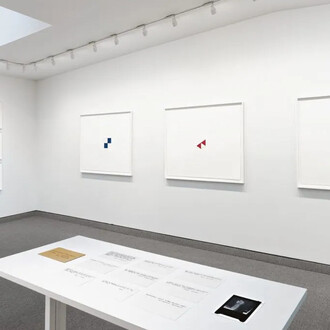I want people to see these works as I see them and I try to, without hitting people over the head, allow them to think … and either make sense of it or not.
(Fred Wilson)
Fred Wilson (b. 1954, Bronx, New York) has long investigated the meanings of symbols and objects as part of his multidisciplinary, research-based practice. Through alteration, juxtaposition, decontextualization, and selection, among other actions, the artist provides opportunities for new interpretations and associations that reframe social and historical narratives. Working across sculpture, painting, photography, collage, printmaking, and installation, Wilson imbues reclaimed images and objects with personal and historical importance. Legacies of colonialism and erasures of Blackness in Western European art are often the subject in his exchanges with these objects of different geographic and temporal origins.
For the current exhibition at Krakow Witkin Gallery, an early sculpture is juxtaposed with a rare, complete suite of photogravures to show both the depth and breadth of the artist’s visual and intellectual explorations.
For Art world (1994), Wilson has taken a found globe and selectively removed Latin America, Eastern Europe, Africa, and most of Asia. Wilson has stated, “At this point I had sort of shifted it because it was really about that time and that the art world was only the United States and Europe, and all these other places were just not there.” The art, though, is not just highlighting the absence, but what happens to the globe with that absence. The physical changes to the found object reveal to the viewer a thin structure supporting an incomplete, warped shape that one can see through but can no longer rotate smoothly. These are changes to the object that are both physical alterations and also serve as lenses with which to see the metaphorical ramifications of a limited “art world”.
The master plan or in between the Big Bang and Modern Art is the restroom (2004-2009) consists of 22 photogravures where Wilson has employed specific gallery floorplans from visitor orientation maps of eighteen European and North American museums of anthropology, art, cultural or natural history. Omitted from these maps are all but a few words and icons of collection care terminology or visitor services signage. Displayed as an immersive installation of evocative but anonymous abstract forms, a viewer can explore one’s own “master narrative” by comparing one plan or symbol usage to the next. The subtitle, In between the Big Bang and Modern Art is the restroom evokes an evolutionary perspective, the legacy of colonialism and imperialism, still embodied today in the organization of materials cared for by Western museums, supported in most cases by a hierarchically distributed space division. Hopefully, while the removal of information leaves room for assumptions, indicators highlighted by the artist enable a clearer path of thinking.
Wilson recalls that, at the beginning of his career, “working simultaneously in the educational department of The Metropolitan Museum of Art, the American Museum of Natural History, and the American Craft Museum made me wonder about how the environment in which cultural production is placed affects the way the viewer feels about the artwork and the artist who made these things”.
The artist’s early work was directed at marginalized histories, exploring how models of categorization, collecting, and display exemplify fraught ideologies and power relations inscribed into the fabric of institutions. His groundbreaking and historically significant exhibition Mining the museum (1992) at the Maryland Historical Society, radically altered the landscape of museum exhibition narratives. As interventions, or “mining,” of the museum’s archive, Wilson re-presented its materials to make visible hidden structures built into the museum system, and American Society as a whole.
Commenting on his unorthodox artistic practice and how it has changed over time, Wilson has said that, although he studied art, he no longer has a strong desire to make things with his hands: “I get everything that satisfies my soul from bringing together objects that are in the world, manipulating them, working with spatial arrangements, and having things presented in the way I want to see them”.
His installations lead viewers to recognize that changes in context create changes in meaning. While appropriating curatorial methods and strategies, Wilson maintains his subjective view of the museum environment and the works he presents. He questions (and forces the viewer to question) how curators shape interpretations of historical truth, artistic value, and the language of display—and what kinds of biases our cultural institutions express.
















